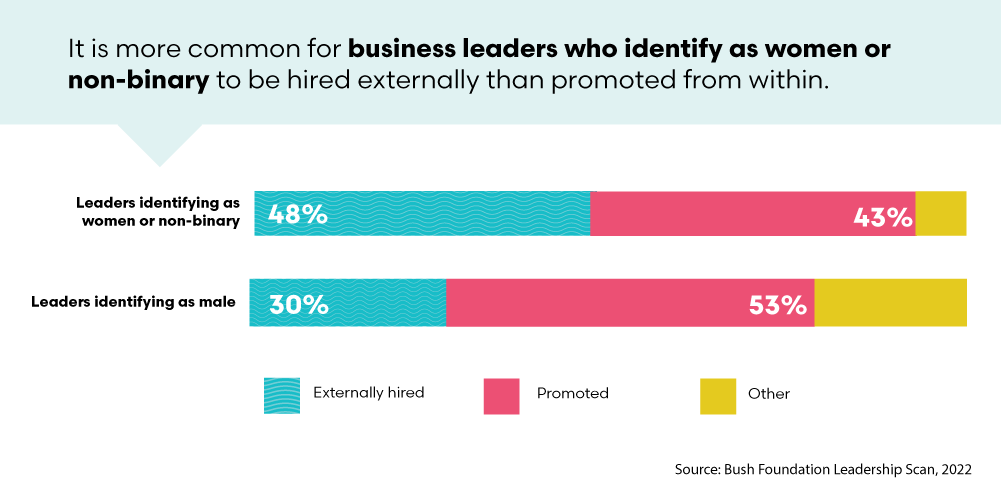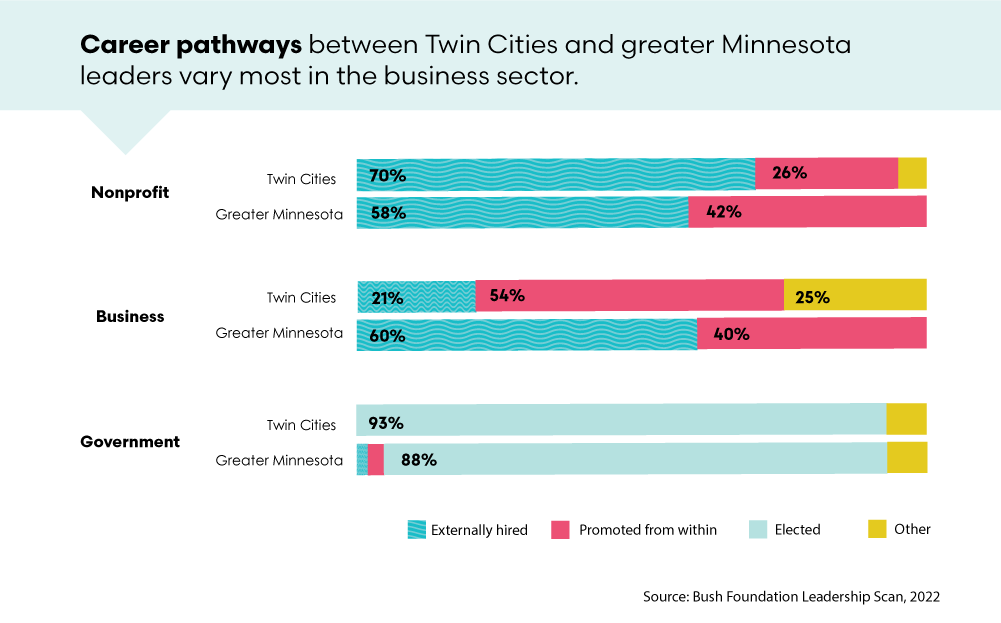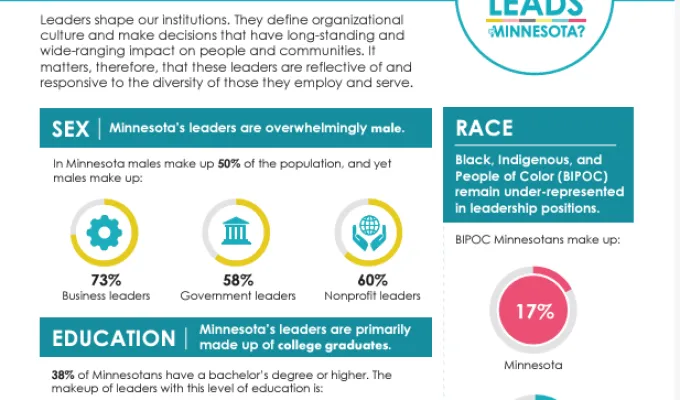by Allison Liuzzi and Caitlin Hamrock
“How did leaders come into their leadership positions?” It’s one of the most common questions we receive about data in our Who Leads in MN? section. And it’s a question that our usual data sources – like the American Community Survey from the U.S. Census Bureau – can’t answer.
So, with support from Bush Foundation and in collaboration with the Minnesota Council of Nonprofits, Minnesota Chamber of Commerce, and the League of Minnesota Cities, we’ve been collecting information to learn more about pathways into leadership. Among the questions we asked over the course of two surveys in 2020 and 2022 were how leaders came into their positions, whether through promotion, external hire, or in the case of government leaders, election or appointment.
That information points to some noticeable differences in how leaders came into their positions, especially in the business sector. But first, let’s start with some context (from our “usual” data sources).
Across sectors, business has the largest gaps in representative leadership.
Our business sector has some of the largest gaps in representative leadership. For example:
- Female leaders are under-represented in Minnesota’s business sector, where 1 in 4 business leaders are women.
- Leaders of color are under-represented in the business sector, where 1 in 10 leaders are Black, Indigenous, or People of Color (BIPOC)
Internal promotion or external hire? It’s different across Minnesota’s sectors.
Over the past two rounds of data collection in 2020 and 2022, we have found that the most common pathways to leadership are not the same across Minnesota’s business, government, and nonprofit sectors. In our most recent survey, about half of business leaders were promoted into their leadership position, while the vast majority of government leaders were elected and most nonprofit leaders were hired into their positions. These unique pathways across the three sectors were consistent in both years of data collection.

Internal or external hire? There are advantages and drawbacks.
There are advantages and disadvantages to how an organization chooses to identify, cultivate, and invest in its leaders. The most common pathway among Minnesota’s business leaders – internal promotion – allows an organization to grow its own leaders who have working knowledge of policies, practices, colleagues, and organizational culture. However, internal promotion can result in organizational stagnation when it limits or misses a pool of candidates who could bring fresh perspectives, unique backgrounds, and innovative ideas.
| PROS | CONS |
|---|---|
| Faster and less expensive, both in terms of hiring and onboarding/training | Misses highly qualified external candidates who can bring creativity and innovation |
| Existing company knowledge and cultural fit, and better performance | Risk of stagnation or lagging innovation within the organization |
| Employee motivation, engagement, and morale, and lower turnover | Adds new vacancies or the need to backfill positions |
The most common pathway among Minnesota’s nonprofit leaders – external recruitment – gives an organization a glimpse at a broader and deeper pool of candidates, who may have more targeted or refined skill sets that align with the job description. The candidate pool also tends to be more demographically diverse than internal candidates alone, especially if implicit hiring biases have shaped the organization in the near or distant past. However, external recruitment is time- and cost-intensive, and can involve a much steeper learning curve for external hires. A recent review of research suggests, for example, that new hires can take 12-24 months to fully integrate into their positions and organizations.
| PROS | CONS |
|---|---|
| Larger supply of candidates and expanded talent pool | Higher cost and more work, both in terms of recruitment and onboarding/training |
| Fresh ideas, perspectives, and strategies, and more refined/targeted skill sets | Steeper learning curve and longer integration period than with internal hired |
| Increased diversity | Existing employee morale, internal politics, and friction |
Is Minnesota’s business sector “growing its own” or “maintaining the status quo”?
Minnesota’s business sector has large gaps in representative leadership. Almost half of business leaders in our survey came into their positions through internal promotion, the most common pathway to leadership in this sector. This means that businesses seeking to diversify their leadership may reap some of the benefits from external hires, including a larger supply of candidates with fresh ideas and diverse backgrounds.
In fact, our survey provides some evidence that Minnesota’s business leaders from under-represented groups – women, non-binary leaders, leaders in greater Minnesota – largely came into their positions through external hire.
- In our survey, the most common pathway to leadership among women and non-binary business leaders was external hire (48%), while internal promotion was the most common pathway for men (53%). This gender difference in promotion versus external hire is not seen in other sectors.

- The most common pathway to leadership among greater Minnesota business leaders in our survey was external hire (60%), compared to promotion from within among Twin Cities business leaders (54%). Given the ways that external hires can potentially lead to more diverse hiring outcomes, businesses seeking to diversify their leadership or “break from the status quo” may want to consider this hiring process.

Learning more and looking ahead
Learn more by heading to our Who Leads in MN? section, which has the latest survey data results from 2022. These data give us a more nuanced understanding of representative leadership, providing information on demographic characteristics that aren’t collected via Census programs. For example, you can find data on leaders by:
- Gender, including non-binary and self-described categories
- Career path
- Disability status, using more comprehensive categories
- Sexual orientation
Looking ahead, our Minnesota Compass team will be administering surveys to Minnesota’s business, nonprofit, and government leaders for the third time in 2025. Stay tuned as we continue to learn more about Minnesota’s leaders and their pathways to leadership.

